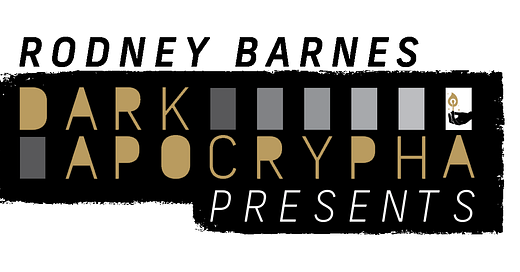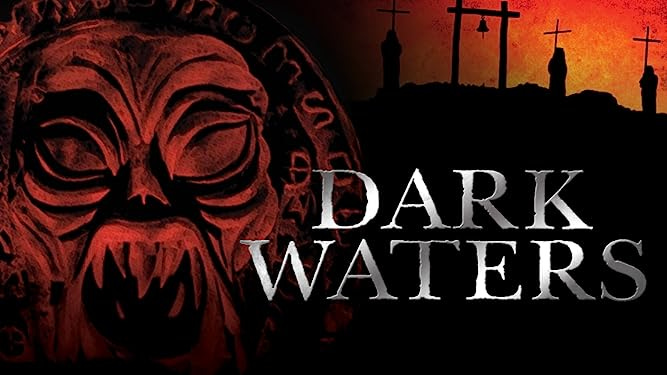Film Apocrypha: Dark Waters
Guest Blogger Noelle Webster salutes Mariano Baino’s Surreal, Lovecraftian Nunsploitation Movie of the 90s
“I am she that liveth and was dead. And behold, I’m alive forevermore and have the keys of Hell and death.”
Thus begins the opening voice over of Mariano Baino’s Dark Waters, an unclassifiable horror gem from 1993 that still hasn’t quite received its due. Dark Waters takes viewers on a journey filled with monsters, gore, scary nuns, blind prophets, and a positively oppressive sense of dread. The movie kicks off with a zoom in on a broken amulet, a skull, and only the sound of a ringing bell. Followed by the striking silhouette of a line of nuns on a cliff’s edge holding giant burning crosses, the mood is set.
Picture ancient catacombs during a storm, the ceiling is leaking and water is dripping into a holy chalice. A priest is stabbed by a cross sharpened to a point, and he bleeds out while being taken by a flood from the storm. You see a POV cam of someone—or something—rushing up to a nun holding an eerie amulet and she falls to her death, shattering the amulet in the process. The fragments are collected and kept separate as nuns hide them in boxes and seal them into catacomb walls. Not a single word has been spoken since the opening voice over, and then a smash cut to a title card that says “20 years later”.
In this opening 8 minutes or so, Baino has effectively set the tone for his exercise in cosmic horror Dark Waters. After the cold open we’re introduced to the protagonist Elizabeth (played by Louise Salter) as she reads a letter from her friend Theresa, asking Elizabeth to come visit her at the island convent where she lives. Ignoring an excess of horror movie red flags, Elizabeth continues to journey to the island.
Red flags that Elizabeth ignores on her way to the island include but are not limited to: A man on the bus staring at her while spiders crawl all over his hands. A local who refuses to take her to the island during the storm, and insists if she just waits he’ll even do it for free. When she does find a ship captain to take her, he’s blatantly creepy and there’s a shirtless man hunched on the deck in the storm absolutely tearing into raw fish with his teeth. The captain dismisses it saying “he keeps the other freaks away”. But despite all this, Elizabeth persists and arrives to the island in the dead of night.
Dark Waters is Italian filmmaker Mariano Baino’s feature film debut, and its production was a troubled one. Shot on location in Ukraine following the collapse of the Soviet Union, the political situation in Ukraine caused several filming problems. But the result is undeniable—the movie is stunning and doesn’t look like anything I’ve seen before or after. The sets and locations are so visually distinct and add so much to the movie’s atmosphere. Old fashioned catacombs, crumbling churches, hundreds of dripping candles, and dreary out-of-time coastlines all set the mood that you shouldn’t be here and that there is no escape. The movie looks like a waking dream, but there’s a realism to the shooting locations make it feel like the viewer is witnessing a place out of time and gives Dark Waters an eerie, disquieting feeling. At first glance, if a viewer didn’t know this was a 1993 movie they might guess that it was made in the 1970s.
In addition to the setting and atmosphere, the nunsploitation genre trappings in Dark Waters give a very 1970s feel. For those unfamiliar, nunsploitation is an exploitation subgenre that—you guessed it—features nuns and most commonly focuses on their sexual repression, depravity, and is often highly critical of religion. Maybe the best-known example of the nunsploitation genre is Ken Russell’s 1971 movie The Devils, an X-rated movie that was banned in several countries due to the explicit content and portrayal of corruption in the church. (It’s excellent.) Nunsploitation movies are rarely found these days, but a recent example would be Paul Verhoeven’s Benedetta which also sparked outrage when it was released in 2021.
While Dark Waters is rightfully considered a classic nunsploitation film, that undersells how many other interesting ideas and choices are present in the movie. The sound design is haunting, and the score is all echoey and dissonant organ music leaving the viewer highly unsettled. Baino takes a very dreamlike and arthouse approach to the film, creating an atmosphere where everything feels wrong and leaves the viewer claustrophobic as if they’re stuck on island too. It’s not one type of movie—it’s a spooky seaside horror movie, it’s a storm movie, and at its core there’s a mystery to be unraveled.
Dark Waters is very much its own unholy beast, but there are clear influences apparent in the film. There are shades of Dario Argento’s Suspiria present, for example when Elizabeth first arrives to the island she’s dressed in a striking red raincoat and heels and is completely drenched in the storm. It can’t help but recall Suzy Bannon first arriving to the ballet academy, and the movie similarly explores a surreal and ominous place the leading woman can’t leave—not to mention ending with a wild third-act twist. Stylistically there are also elements of Lucio Fulci’s The Beyond and even a dash of Clive Barker’s Hellraiser. Most prevalent however is the influence of H.P. Lovecraft, which is noted by the director himself.
In an interview for JoBlo.com, Baino says “There isn’t anything in Dark Waters that was, consciously, directly inspired by Lovecraft, but his influence permeates the film. There are so many elements which one would define as Lovecraftian: the weirdness of the place, the isolation, the atmosphere of constant dread, finding oneself in a world that seems to operate on a completely different set of rules from the ones we are used to in our own dimension, and, of course, the half-glimpsed demon who threatens to precipitate the apocalypse.”
The movie may be heavy on dread and nightmarish imagery, but it doesn’t skimp on the tangible horror. As Elizabeth discovers more and more about the island she witnesses steadily more insane things, the movie descends into pure madness. Otherworldly monsters, cannibalism, repressed memories, occult rituals, body horror, and so much more. If you have the stomach for it, you’ll find Dark Waters has something uniquely horrifying to offer.
Noelle Webster is a film writer, a lover of all things genre, and Dolph Lundgren’s number 1 fan.




